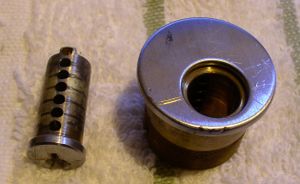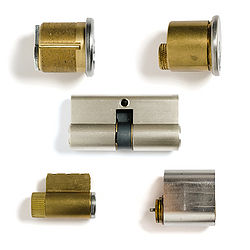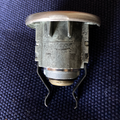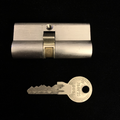Cylinder: Difference between revisions
m (→Cylinder Types: formatting) |
m (→Cylinder Types: <h3> test) |
||
| Line 13: | Line 13: | ||
<!--[[Image:cylinder types - FXE47651.jpg |thumb|250px|Clockwise from top left: mortise, rim, KIK, and euro profile cylinders]]--> | <!--[[Image:cylinder types - FXE47651.jpg |thumb|250px|Clockwise from top left: mortise, rim, KIK, and euro profile cylinders]]--> | ||
<h3>Mortise</h3> | |||
A threaded cylinder that screws into a [[door]] assembly and is held in place by set screws on each side. | A threaded cylinder that screws into a [[door]] assembly and is held in place by set screws on each side. | ||
Revision as of 12:54, 4 January 2023
Cylinder

A cylinder (or shell, housing) is a lock component which holds the plug, actuator, and locking components. Though most commonly associated with pin-tumbler based lock designs, cylinders are used in many others, such as wafer, lever, and disc-detainer locks.
Cylinder Types
Mortise
A threaded cylinder that screws into a door assembly and is held in place by set screws on each side.
Rim
A cylinder that is held in place by screws that extend through the cylinder itself.
Key in Knob (KIK)
A cylinder that is inserted into a knob or housing, held in place by various methods depending on the housing's design.
Euro Profile
A cylinder of a standard european format that is held in place by a screw that extends through the center of the cylinder.
Oval
The three common oval-shaped cylinders are known as the Scandinavian Oval (or Nordic Oval), the UK Oval, and the Australian Oval (or 570 Oval). The 570-type is a reference to the Lockwood 570.
Gallery
See also
| This article is a stub. You can help Lockwiki by expanding it. |








